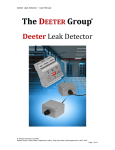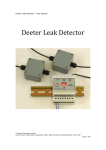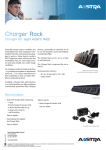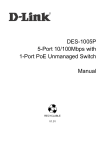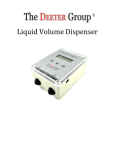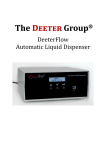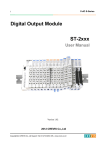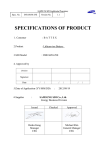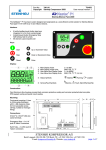Download the Leak Detector System User Guide
Transcript
Deeter Leak Detector – User Manual Deeter Leak Detector © Deeter Electronics Limited Deeter House, Valley Road, Hughenden Valley, High Wycombe, Buckinghamshire. HP14 4LW Page 1 of 11 Deeter Leak Detector – User Manual Table of Contents 1. 2. Summary ........................................................................ 3 Leak Detect Controller ...................................................... 3 2.1 Controller Electrical Connections............................. 4 2.2 LED Indicators ..................................................... 5 2.3 Option Switches ................................................... 6 3. Leak Sensors ................................................................... 8 Specifications ......................................................................... 11 © Deeter Electronics Limited Deeter House, Valley Road, Hughenden Valley, High Wycombe, Buckinghamshire. HP14 4LW Page 2 of 11 Deeter Leak Detector – User Manual 1. Summary The Deeter Leak Detector comprises a Leak Detect Controller and a set of Leak Sensors. The Controller will respond to a leak detected at any one of the Sensors. The Controller provides an LED indication of the system status and has relays and a transistor output that may be used to directly drive pumps and alarms, or may be used to interface to other equipment, such as Programmable Logic Controllers (PLC), Building Management Systems (BMS) and dial-up alarms systems. The Controller has a wide range of power supply options, with separate inputs for mains-voltage supplies (220-240VAC) and low-voltage supplies. Low-voltage supplies can range between 8-24V AC and 10-32V DC. A number of user-selectable options are provided by a bank of 6 switches behind the Controller front panel. These are visible through the front panel but only accessible with the panel removed, so cannot accidentally be changed. 2. Leak Detect Controller The Leak Detect Controller is housed in a UL94-V0 flame retardant case that will fit to standard 35mm DIN rail. © Deeter Electronics Limited Deeter House, Valley Road, Hughenden Valley, High Wycombe, Buckinghamshire. HP14 4LW Page 3 of 11 Deeter Leak Detector – User Manual 2.1 Controller Electrical Connections All electrical connections are made via two rows of screw terminals as shown: Top Row (5mm spacing) Leak Sensor supply +ve Leak Sensor input Leak Sensor supply –ve 0V Alarm output Unregulated supply output Power supply input –ve Power supply input +ve The top row (5mm spacing) has terminals grouped in twos and threes according to function and are used for low-voltage connections only (less than 50V). Bottom Row (7.5mm spacing) Relay 1 NC (Normally Closed) Relay 1 NO (Normally Open) Relay 1 COM (Common) Relay 2 NC Relay 2 NO Relay 2 COM Mains supply ‘Neutral’ Mains supply ‘Live’ (230VAC) The bottom row (7.5mm spacing) may be used for connecting mains-supply voltages (220V-240V) or low voltages if the Controller is not powered by mains. (Mixing mains and low voltages on the bottom row of terminals is not recommended for electrical safety reasons). © Deeter Electronics Limited Deeter House, Valley Road, Hughenden Valley, High Wycombe, Buckinghamshire. HP14 4LW Page 4 of 11 Deeter Leak Detector – User Manual There are two pairs of power supply terminals: a low-voltage pair on the top row and a mains voltage pair on the bottom row. Connect to one pair only. The unregulated output is a DC voltage derived from the supply (AC, DC or mains) and the voltage level will depend on the supply and load. It may be used to power external devices with return current via the 0V or ‘Alarm’ terminals. The open-collector transistor ‘Alarm’ output is current-limited to sink up to 50mA and can be pulled up to 40V. It is open during normal operation and can be used in conjunction with the unregulated supply output to drive an external relay. It may also be used to interface to other equipment, such as a PLC or BMS, or it can be connected to the Leak Sensor input of another Leak Controller to provide additional relay contacts. The relays have a current rating of 6A at 250VAC. 2.2 LED Indicators There are three LED indicators on the top panel: green, yellow and red. These show the current state of the Leak Detect Controller as follows: Operating State System okay – no leak or line fault Leak detected Leak latched (leak has passed) Fault detected Leak latched and fault detected Green On Yellow Red On Flashing On On Flashing © Deeter Electronics Limited Deeter House, Valley Road, Hughenden Valley, High Wycombe, Buckinghamshire. HP14 4LW Page 5 of 11 Deeter Leak Detector – User Manual 2.3 Option Switches There are six DIP switches on the top panel, used to select a range of options. To gain access to the switches, prise off the top panel using a flat bladed screwdriver in the gap to the left or right-hand side of the cover. The switches have the following functions: Switch No. 1 2 3 4 5 6 Relay 2 Alarm Relay 1 Relay 2 Alarm Relay1&2 default OFF (down) Assigned to Leak Assigned to Leak Follows Follows Follows Off ON (up) Assigned to Fault Assigned to Fault Latches Latches Latches On Relay 1 is always assigned to leak detection. If there is a fault detected on the Leak Sensor line, Relay 2 and/or the Alarm output can be used to indicate the fault. Fault conditions include: A break on any of the three Leak Sensor wires Shorting between Leak Sensor wires Poor termination of the Leak Sensor wires Blown output fuse The Alarm output and both relays can be set to follow a leak condition or to latch. If following, the output will change back when conditions are dry. If latching, the outputs will remain on, even after a leak has been cleared. © Deeter Electronics Limited Deeter House, Valley Road, Hughenden Valley, High Wycombe, Buckinghamshire. HP14 4LW Page 6 of 11 Deeter Leak Detector – User Manual Pressing the Reset button on the top panel will unlatch the outputs and return the Controller to its quiescent state. Fault outputs are not latched and always return to normal once the fault condition has been cleared. If an output is assigned to Fault and also selected to latch, the red indicator will flash after a leak has cleared. In this configuration, although no outputs may latch, the leak event indication will still latch with the red indicator flashing until the operator presses the reset button. The relays can be configured to connect power or remove power to equipment when a leak (or fault) is detected by using either the NC or NO contacts. Switch 6 allows this choice to be based on fail-safe conditions so that if power is lost to the Controller the attached equipment can default to either on or off, whichever is safe. Example1. A pump must come on when a leak is detected but remain off if the detector system is switched off. Use the NO contacts and set Switch 6 so that relays default to Off. Example 2. A siren must sound if a leak is detected or if the detector system is switched off. Use the NC contacts and set Switch 6 so that relays default to On. Isolation of both supply lines may be a requirement for some mains-powered equipment. The two single-pole relays can be used as a double-pole relay if they are both assigned to leaks and both set to latch or follow in the same manner. © Deeter Electronics Limited Deeter House, Valley Road, Hughenden Valley, High Wycombe, Buckinghamshire. HP14 4LW Page 7 of 11 Deeter Leak Detector – User Manual 3. Leak Sensors Leak Sensors are housed in ABS enclosures with a pair of stainless steel sensing probes protruding through the underside. The probes will detect ‘normal’ water to a depth of around 1 to 2mm. They will detect other conducting fluids or purer water but may require greater depth of contact with the fluid. To achieve greater contact, or to enable the probes to reach further, they can be extended using an M3 threaded spacer. Sensors are linked using a 3-wire cable in a daisy-chain configuration. Screw terminals are provided for connections from the Controller (or previous Sensor in the chain) and out to the next Sensor in the chain. The last Sensor in the chain must terminate the wires so that if a wire becomes broken, the Controller can detect the break and report a fault. Sensor with lid removed showing line-termination links © Deeter Electronics Limited Deeter House, Valley Road, Hughenden Valley, High Wycombe, Buckinghamshire. HP14 4LW Page 8 of 11 Deeter Leak Detector – User Manual Sensor terminal numbers Screw terminals must be kept dry, so cables are fed through cable glands and the box lid can be sealed to IP65. Remove the lid to reveal the screw terminals, which have the following functions: 3-way Terminal Number Function Terminal 1 is close to the side of the enclosure 1 2 3 6-way Terminal Number Power supply +ve Common sensor output Power supply –ve Function Terminal 1 is opposite terminal 1 on the 3-way connector 1 2 3 4 5 6 Power supply +ve Common sensor output OR Line termination – connect to Power supply –ve Line termination – connect to Line termination – connect to Line termination – connect to 4 2 6 5 The line-termination connections are for the final Leak Sensor in the chain. Remember to seal the unused cable gland on the final Sensor, a blanking plug is provided. © Deeter Electronics Limited Deeter House, Valley Road, Hughenden Valley, High Wycombe, Buckinghamshire. HP14 4LW Page 9 of 11 Deeter Leak Detector – User Manual Sensors have two mounting holes that can be used to bolt them to the floor if required. The mounting holes are accessible with the lid removed. Sensor Wiring Diagram 3 Sensors with line-termination links shown on the final Sensor in the chain Mains Power Supply (230VAC) OR Low Voltage Supply (12V/24V AC/DC) Please note that although a break in the wires connecting the sensors will be detected automatically, in the unlikely event of a sensor failure, there will be no indication of a fault. All Leak Sensors should therefore be tested periodically to confirm that they are functioning correctly by placing the probes in the fluid they are required to detect. © Deeter Electronics Limited Deeter House, Valley Road, Hughenden Valley, High Wycombe, Buckinghamshire. HP14 4LW Page 10 of 11 Deeter Leak Detector – User Manual Specifications Controller dimensions: 90mm high x 71mm wide x 58mm deep 35mm DIN rail mounting Sensor dimensions: 100mm (including cable glands) x 64mm x 40mm high Sensor probes: Pair, 5mm long, stainless steel, M3 thread, spaced at 20mm centres Mains power supply option: Low-voltage supply option: 220VAC – 240VAC at 20mA 10VDC – 32VDC at 200mA 8VAC – 24VAC at 200mA Relay contacts: ‘Alarm’ transistor output (resistive loads): 6A at 250VAC Current limited to maximum 50mA Maximum pull-up voltage, 40VDC. Maximum number of Sensors: Maximum cable length: 25 typically 2000m, depending on wire resistance Mains supply fuse: Low-voltage supply fuse: Sensor output fuse: Unregulated output fuse: 32mA anti-surge, 5x20mm cartridge ® 500mA anti-surge, Omni-Blok cartridge 375mA anti-surge, Omni-Blok® cartridge 100mA anti-surge, Omni-Blok® cartridge © Deeter Electronics Limited Deeter House, Valley Road, Hughenden Valley, High Wycombe, Buckinghamshire. HP14 4LW Page 11 of 11











